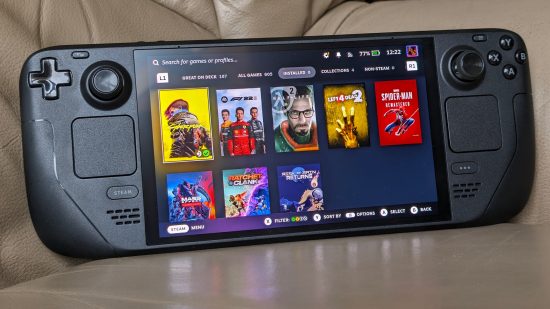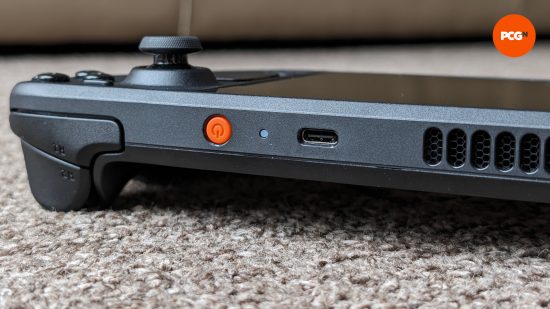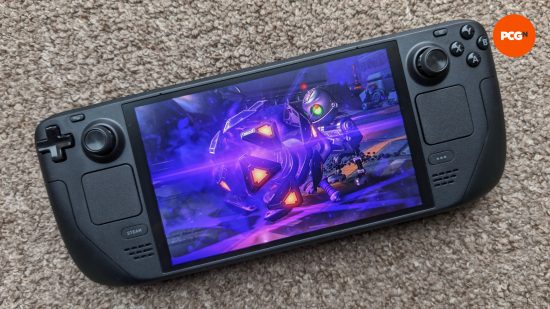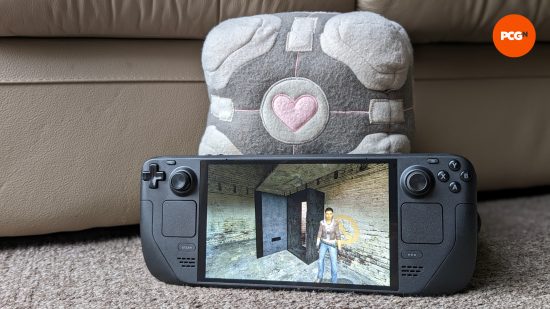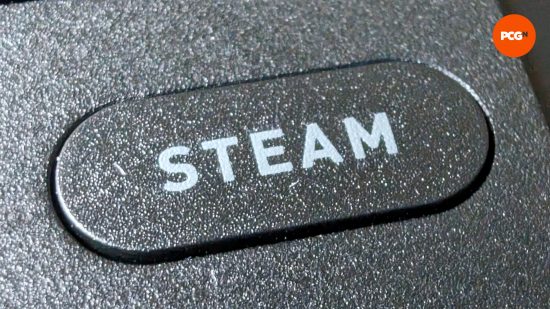Our Verdict
The Steam Deck OLED is the best handheld PC on the market today. Its screen is a sight to behold as it breathes new life into games new and old alike. While it does fall behind in performance versus its competition, the amount on offer here for its price provides fantastic value.
- OLED transforms gaming experience
- Greatly improved battery life
- Cooler and quieter than original Steam Deck
- APU performance remains unchanged
- Isn't available with less than 512GB of storage
- SteamOS still has a few annoying quirks
I, like many others, have been calling for a Steam Deck OLED ever since laying eyes, and eventually hands, on the original Steam Deck. Valve has since answered these calls and taken the opportunity to not only upgrade the gaming handheld’s display but also improve it in a myriad of other ways. These enhancements come together in an undeniably transformative fashion, making it difficult to return to or justify buying the original Steam Deck.
For the past week, I’ve been putting the Steam Deck OLED through its paces. In that time, the quality of its screen, better lasting battery life, and other improvements have helped to rekindle my appreciation for the device and the best Steam Deck games you can play on it. However, while this may be the best version of Valve’s handheld we’re likely to see it for a long while, and it’s one of the best handheld gaming PCs, with a few issues holding it back from being a practically perfect portable PC.
Why you can trust our advice ✔ At PCGamesN, our experts spend hours testing hardware and reviewing games and VPNs. We share honest, unbiased opinions to help you buy the best. Find out how we test.
Steam Deck OLED specs
While the Steam Deck OLED specs share some similarities with the original model – herein referred to as the Steam Deck LCD – there are a surprising number of differences between the two models.
| Steam Deck OLED | Steam Deck LCD | |
| CPU | AMD Zen 2 (4 cores / 8 threads) (6nm) | AMD Zen 2 (4 cores / 8 threads) (7nm) |
| GPU | AMD RDNA 2 (8 CUs) | AMD RDNA 2 (8 CUs) |
| RAM | 16GB LPDDR5 (6,400MT/s) | 16GB LPDDR5 (5,500MT/s) |
| Display | 7.4-inch OLED (1280 x 800 / 90Hz / HDR) | 7.0-inch IPS (1280 x 800 / 60Hz) |
| Battery | 50WHr | 40WHr |
| Storage | 512GB NVMe SSD 1TB NVMe SSD |
64GB eMMC 256GB NVMe SSD 512GB NVMe SSD |
| Weight | 640g | 669g |
| Size | 298mm x 117mm x 49mm | 298mm x 117mm x 49mm |
Naturally, the most obvious quality separating the Steam Deck OLED and Steam Deck LCD from one another is their screen, but this extends past panel technology. The display on the former is 0.4 inches larger and boasts a boosted refresh rate of 90Hz, in addition to supporting HDR.
Under the chassis, meanwhile, the Steam Deck OLED packs a higher capacity 50WHr battery, as well as an APU designed and manufactured with a more efficient 6nm process. Both of these upgrades contribute to much-improved battery life, with the OLED panel also providing an additional efficiency boost versus the previous LCD solution.
Valve has also decked out the Steam Deck OLED with faster 6,400MT/s RAM, but the company has left the CPU and GPU configuration of its APU unchanged. As such, you’ll need to continue waiting for the Steam Deck 2 for any significant uplifts in performance.
In putting together these refreshed internals, Valve has adjusted the layout of components inside the Steam Deck OLED, creating room for a beefier cooling setup. This in turn makes it much quieter and cooler under load than the Steam Deck LCD.
Steam Deck OLED design
At a glance, the Steam Deck OLED design appears identical to the Steam Deck LCD, with both models sharing the same dimensions. On closer inspection, however, there are a few things that characterize the two devices.
For instance, there are small things like the Steam Deck OLED opting for a dark gray color scheme for its buttons and thumbsticks, in place of the off-white Steam Deck LCD. It’s not entirely devoid of flair, however, with Valve painting the power button with a splash of orange.
The most notable difference between the Steam Deck OLED and LCD, though, is weight. The 29g that separates the two portable PCs has a surprisingly large effect on how comfortable each of them is to hold, particularly for long periods.
Finally, picking up the 1TB Steam Deck OLED will also net you a new carrying case. It features a Velcro strap, in addition to the zipper, for greater peace of mind that your Deck is tucked away safely and snugly. The liner inside this case is also removable, allowing you to shove it into your backpack without it taking up as much space.
Steam Deck OLED display
There is simply no other handheld out there that competes with the Steam Deck OLED display, with its quality being so high that it even puts some of the best gaming monitors to shame. Everything bar resolution has seen a massive uptick in quality, including colors, contrast, response times, viewing angles, and more.
Games look stunning in both SDR and HDR on the Steam Deck OLED, with its display’s inky blacks providing sensational contrast against the vibrant spectrum of colors it can produce. They feel better than they ever did on the Steam Deck LCD, too, thanks to the much-improved response time (<0.1ms) and 90Hz refresh rate. These two factors in particular make playing FPS games like Left 4 Dead 2 on the Deck much more enjoyable.
The larger 7.4-inch panel, combined with smaller bezels, also provides a greater sense of immersion in more cinematic single-player titles. It also makes reading text on the Steam Deck a touch easier, but this naturally varies from game to game.
Steam Deck OLED battery
Valve has made significant strides in boosting the Steam Deck OLED battery versus the Steam Deck LCD. While the larger 50WHr battery and an array of efficiency savings all contribute to a longer battery life, it’s honestly a little mind-boggling how much better it is.
While the Steam Deck LCD lasts for one hour and fifty minutes in our gaming tests, the Steam Deck OLED musters a whopping three hours and twenty-six minutes, when both devices are capped at 60 frames per second. Even then, the new model clocks in at two hours and fourteen minutes with a 90fps cap.
Better still, you can expect to squeeze the same amount of playtime from the Steam Deck OLED regardless of whether you’re playing games in SDR or HDR. The device also charges faster, taking just 45 minutes to fill up from 20% to 80%.
Steam Deck OLED performance
Given that the APU inside the Steam Deck OLED is almost identical to the one powering the Steam Deck LCD, save for efficiency, there’s no tangible performance difference between the two. At best, you can expect a few extra frames here and there in some games, but it’s nothing earth-shattering.
This places the Steam Deck OLED significantly behind the curve of more powerful handhelds, armed with more recent and capable hardware. It also leaves some recent releases, like Returnal, completely out of reach. To be clear, this was and remains the case for the Steam Deck LCD too.
Ultimately, though, this weakness is much easier to swallow given how many games are playable on the Steam Deck OLED. Both Proton and SteamOS have come a long way since our original Steam Deck review, with a much greater level of support for games new and old. Even so, it’s still not quite the seamless experience it should be, with miscategorized games, continued cumbersome issues with third-party launchers, and the wealth of titles still yet to receive a compatibility rating from Valve.
Despite these shortcomings, SteamOS nonetheless provides the most convenient, console-like experience available on a handheld PC. It’s the better option versus Windows 10 or 11 and only continues to get better with each passing week through constant updates from Valve.
Steam Deck OLED price
Steam Deck OLED pricing starts at $549 for the 512GB model, jumping up to $649 for the 1TB version. There is also a Limited Edition Steam Deck OLED available for $680, but stock is extremely limited and is exclusive to North America.
Both the Steam Deck OLED 512GB and 1TB are set to replace the 256GB and 512GB LCD models, respectively. While the latter of the original handhelds is set to be discontinued, the former will replace the 64GB version at $399. As the 64GB and 512GB models are phased out, they can be picked up at a discount while stocks last.
Should you buy the Steam Deck OLED?
The Steam Deck OLED is better value than the likes of the Asus ROG Ally or Lenovo Legion Go, costing less and packing a display that blows the competition away. If you’re looking for a well-priced handheld and don’t want or need a Windows operating system, it’s a great choice.
As someone who’s enjoyed spending the past year playing all kinds of games on my Steam Deck LCD, it’s hard not to get caught up in the excitement surrounding the Steam Deck OLED. In short, it is a triumph, a huge success, it’s hard to overstate my satisfaction, and I can’t wait to see what Valve has in store for the Steam Deck 2.
Alternatives
If the Steam Deck OLED isn’t the perfect handheld for you, check out some of our alternate recommendations:
Steam Deck LCD
While the Steam Deck OLED may be the best version of Valve’s handheld, the Steam Deck LCD still has plenty to offer. Games perform almost identically on the two models, and the Steam Deck LCD does carry a lower price tag.
Asus ROG Ally
The Asus ROG Ally is more powerful than the Steam Deck OLED, but this level of performance carries a higher asking price. It also uses Windows 11 as its operating system, rather than SteamOS.
